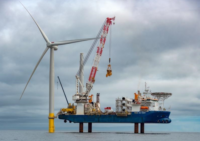The Biden Administration gave long-awaited final approval on May 11 to the first commercial scale offshore wind farm built in the U.S. and permitted in federal waters—the 800-MW Vineyard Wind project, set for construction off the coast of Massachusetts.
The $2.8-billion project's final green light had been expected in 2019 but was delayed by a last-minute Trump administration order to dramatically broaden its environmental impact review that was followed by a permit process halt last December.
The Biden Administration, which has set a goal to have 30 GW of U.S. offshore wind online by 2030, restarted the approval process.
Vineyard Wind, a joint venture of Avangrid Renewables and Copenhagen Infrastructure Partners, won the first Massachusetts offshore wind solicitation in 2018. Its final approval from the U.S. Interior Dept. includes permits from the U.S. Army Corps of Engineers, Bureau of Ocean Energy Management and others.
A second Massachusetts project, the 804-MW Mayflower Wind being developed by Shell and EDF Renewables, will have its first public forum on May 18. It is being sited on a 192-sq-mile federal lease site 20 miles south of Nantucket Island.
The federal lease for Vineyard Wind was awarded in 2015, followed by its submittal of federal and construction applications two years later and the successful bid for the Massachusetts contract in 2018.
The company expects to reach financial close for the project in the second half of 2021, with construction then set to start that will include cable connections to a substation in Barnstable, Mass. It will begin operating in late 2023.
Tne project reached agreement with the New England grid operator last October to connect its power supply.
Vineyard Wind's record of decision (ROD) "is not about the start of a single project, but the launch of a new industry," Lars Pedersen, CEO of Vineyard Wind said in a statement, noting the “long road” to reach the federal approval.
Good Neighbor
The project is approved for 84 wind turbines, but by using General Electric 13-MW capacity Haliade X turbine, it can can deliver 800 MW with 62 turbines, Vineyard Wind said. The turbines will be spaced one nautical mile apart in an array that was endorsed by the U.S. Coast Guard for fishing and navigational safety.
All major Vineyard Wind construction contracts with suppliers and contractors have been secured and the utility is finalizing "evaluation of optimal financing structures" including tax equity and project financing, Avangrid CEO Dennis Arriiola said in a May 6 earnings announcement.
“Wiith the ROD in hand, we can finally get started creating the good paying union jobs this project is going to bring to our state and region,” Frank Callahan, president of the Massachusetts Building Trades said. The project will be built under a project labor agreement, said U.S. Commerce Secretary Gina Raimondo.
She was Rhode Island governor when the first U.S. offshore wind project, sized at 30 MW off the state's Block Island, was completed in 2017. A pilot 12-MW project also operates in federal waters off the Virginia coast.
Vineyard Wind has agreed to provide an estimated $37 million to Massachusetts and Rhode Island fishing industries for potential loss of revenue and to .improve movements in and around the lease area.
The Massachusetts project also will continue funding pre- and-post construction survey studies with the University of Massachusetts and the state lobster fishing trade group to measure marine environment impacts, plus "invest millions of dollars to develop and deploy innovative technologies" to protect "the critically endangered North American Right Whale," said a state announcement.
Turbines will be located a minimum of 15 miles off the coast of Martha’s Vineyard and will be painted to reduce visual impacts to historical properties, project officials said.
Vineyard must still submit a facility design report and a fabrication and installation report, which provide specific details for how the project will be fabricated and installed following the company’s federally approved construction and operations plan.
Ready for More
Meanwhile. Massachusetts announced May 10 it plans to award contracts for two additional projects totaling up to 1.6 GW in December, its largest ever single solicitation.
Bids are due by Sept. 23, with project selections set for Dec. 17, negotiated contracts by March 2022 and state approval by April 2022.
Construction will be financed with power contracts with three electric utilities—Eversouce, National Grid and Unitil.
That is in addition to the 1.6 GW now split between Vineyard Wind and the Mayflower Wind project, approved in 2019. The latter is set to operate by 2025.
The Baker administration said the larger contracts could bring costs down through economies of scale. Economic development potential and cost to ratepayers will be important factors in the selection, the state said.
Lease rights off the Massachusetts coast are held by Vineyard Wind, Equinor, Mayflower Wind and Bay State Wind, all of which can compete for the new contracts.
But the new state contracts will require bidders to provide detail on workforce diversity efforts for themselves and their suppliers, as well as potential for economic development and "environmental justice" impacts. That component of the bids now will make up 30% of scoring, with price 70%, compared to a 25%-75% split in previous bidding.
New Massachusetts climate legislation enacted in March also requires utilities in the state to acquire an added 2.4 GW of offshore wind by 2027.
Projects that start construction before 2026 can gain a 30% federal investment tax credit.
About 3 GW of federal and state ocean capacity also is set for auction by next year off Rhode Island, New York and Connecticut.






